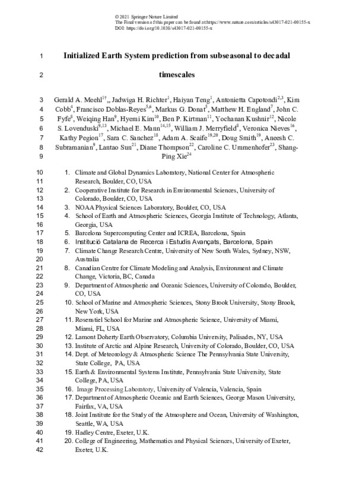Mostra el registre d'ítem simple
Initialized Earth System prediction from subseasonal to decadal timescales
| dc.contributor.author | Meehl, Gerald A. |
| dc.contributor.author | Richter, Jadwiga H. |
| dc.contributor.author | Teng, Haiyan |
| dc.contributor.author | Doblas-Reyes, Francisco |
| dc.contributor.author | Donat, Markus |
| dc.contributor.other | Barcelona Supercomputing Center |
| dc.date.accessioned | 2021-05-10T10:45:28Z |
| dc.date.available | 2021-10-13T00:27:47Z |
| dc.date.issued | 2021 |
| dc.identifier.citation | Meehl, G.A. [et al.]. Initialized Earth System prediction from subseasonal to decadal timescales. "Nature Reviews Earth & Environment", 2021, |
| dc.identifier.issn | 2662-138X |
| dc.identifier.uri | http://hdl.handle.net/2117/345361 |
| dc.description.abstract | Initialized Earth System predictions are made by starting a numerical prediction model in a state as consistent as possible to observations and running it forward in time for up to 10 years. Skilful predictions at time slices from subseasonal to seasonal (S2S), seasonal to interannual (S2I) and seasonal to decadal (S2D) offer information useful for various stakeholders, ranging from agriculture to water resource management to human and infrastructure safety. In this Review, we examine the processes influencing predictability, and discuss estimates of skill across S2S, S2I and S2D timescales. There are encouraging signs that skilful predictions can be made: on S2S timescales, there has been some skill in predicting the Madden–Julian Oscillation and North Atlantic Oscillation; on S2I, in predicting the El Niño–Southern Oscillation; and on S2D, in predicting ocean and atmosphere variability in the North Atlantic region. However, challenges remain, and future work must prioritize reducing model error, more effectively communicating forecasts to users, and increasing process and mechanistic understanding that could enhance predictive skill and, in turn, confidence. As numerical models progress towards Earth System models, initialized predictions are expanding to include prediction of sea ice, air pollution, and terrestrial and ocean biochemistry that can bring clear benefit to society and various stakeholders. |
| dc.description.sponsorship | The foundations of this Review emerged from a workshop held by the National Academies of Sciences, Engineering and Medicine in 2015 at Woods Hole, MA, USA, and the authors gratefully acknowledge support from A. Purcell and N. Huddleston. G.A.M., J.H.R. and N.R. were supported in part by the Regional and Global Model Analysis (RGMA) component of the Earth and Environmental System Modeling Program of the US Department of Energy’s Office of Biological & Environmental Research (BER) via National Science Foundation IA 1844590, and by the National Center for Atmospheric Research (NCAR), which is a major facility sponsored by the National Science Foundation (NSF) under Cooperative Agreement No. 1852977. M.H.E. acknowledges support from the Australian Research Council (Grant CE170100023). H.T. was partly supported by DOE/BER RGMA HiLAT-RASM. M.E.M. was supported by a grant from the NSF Paleoclimate Program #1748097. F.D.-R. and M.G.D. were supported by the H2020 EUCP project under Grant agreement no. 776613, and M.G.D also by the Ramón y Cajal 2017 grant reference RYC-2017-22964. A.C. acknowledges support from the National Oceanic and Atmospheric Administration (NOAA) Climate Program Office’s Modeling Analysis, Prediction and Projections (MAPP) Program and from the NOAA Climate Program Office’s Climate Variability and Predictability (CVP) Program. A.C.S. acknowledges support from the NOAA Climate Variability and Predictability Program (Award NA18OAR4310405) and NOAA-MAPP (NA17OAR4310106). N.S.L. is grateful for support from the NSF (OCE-1752724). D.T. acknowledges support from the NCAR Advanced Study Program and NSF (OCE-1931242). S.C.S was supported by the Joint Institute for the Study of the Atmosphere and Ocean (JISAO) Postdoctoral Fellowship. A.A.S. and D.S were supported by the Met Office Hadley Centre Climate Programme funded by the Department for Business, Energy & Industrial Strategy (BEIS) and Department for Environment, Food and Rural Affairs (Defra) and by the European Commission Horizon 2020 EUCP project (GA 776613). |
| dc.format.extent | 18 p. |
| dc.language.iso | eng |
| dc.publisher | Springer Nature |
| dc.subject | Àrees temàtiques de la UPC::Enginyeria agroalimentària::Ciències de la terra i de la vida |
| dc.subject.lcsh | Earth systems data and models |
| dc.subject.lcsh | Seasonal prediction (Meteorology) |
| dc.subject.other | Climate and Earth system modelling |
| dc.subject.other | Climate sciences |
| dc.subject.other | Projection and prediction |
| dc.title | Initialized Earth System prediction from subseasonal to decadal timescales |
| dc.type | Article |
| dc.subject.lemac | Climatologia -- Mètodes de simulació |
| dc.identifier.doi | 10.1038/s43017-021-00155-x |
| dc.description.peerreviewed | Peer Reviewed |
| dc.relation.publisherversion | https://www.nature.com/articles/s43017-021-00155-x |
| dc.rights.access | Open Access |
| dc.description.version | Postprint (author's final draft) |
| dc.relation.projectid | info:eu-repo/grantAgreement/EC/H2020/776613/EU/European Climate Prediction system/EUCP |
| local.citation.publicationName | Nature Reviews Earth & Environment |
| dc.description.authorship | "Article signat per 26 autors/es: Gerald A. Meehl, Jadwiga H. Richter, Haiyan Teng, Antonietta Capotondi, Kim Cobb, Francisco Doblas-Reyes, Markus G. Donat, Matthew H. England, John C. Fyfe, Weiqing Han, Hyemi Kim, Ben P. Kirtman, Yochanan Kushnir, Nicole S. Lovenduski, Michael E. Mann, William J. Merryfield, Veronica Nieves, Kathy Pegion, Nan Rosenbloom, Sara C. Sanchez, Adam A. Scaife, Doug Smith, Aneesh C. Subramanian, Lantao Sun, Diane Thompson, Caroline C. Ummenhofer & Shang-Ping Xie" |
Fitxers d'aquest items
Aquest ítem apareix a les col·leccions següents
-
Articles de revista [390]


